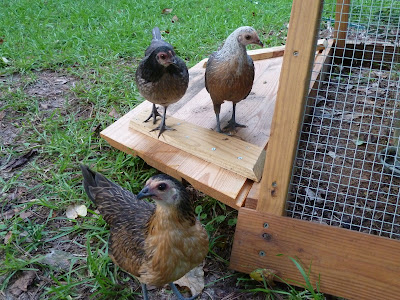In many posts, I’ve suggested that the best way to find out just where your food comes from is to talk to the farmer that produces it. The opportunity for me to do just that arose recently during “Open Farms Day”. To encourage farming and food education, the province of Manitoba organized this event, which included around 40 open houses at participating farms. To take advantage of this opportunity, I took a 45 minute drive and spent some time on the Blue Lagoon, certified organic farm. Here are a few highlights.
My visit began with a walk through a chicken coop. The chickens barely noticed me, they were busy pecking at melon rinds outside of their coop. I couldn’t help but ask, don’t chickens eat grain? Sure, replied Stefan, a farmer and Manitoban chef. He explained that the chickens are happy to eat parts of their food compost, and they especially love fruit seeds. Stefan continued to explain that the melon rinds were left over from his gelato experiment. In fact, Stefan explained that the chickens are great composters, they work food remains into the ground as they peck and graze. This year Blue Lagoon has not used any mechanical tilling of the soil. Instead, chickens are moved around to different soil patches. Just letting the chickens roam around can help transform the soil from hard unworkable land to aerated and more fertile ground.
Next, I hopped on a wagon towed by a tractor and was greeted by Stefan’s parents, Lori Ann and Rene. Clearly proud of their farm, which was recently certified as organic (the only one in St. François Xavier), they explained how every patch of land has its purpose. In the fields you could find rows of veggies, each row a different species, and within rows different varieties. Less fertile land was filled with alfalfa plants. Alfalfa breaks up hard soil and also provides a natural source of nitrogen. It looked perfect if you ask me. But, as Lori Ann soon pointed out, things weren't as simple as they looked. She drew our attention to the live raccoon traps within the fields, as well as garbage bag flags used to deter hungry mammals. Some of their most common visitors are deer. Deer are especially fond of their organic strawberries. So much so these farmers confessed to have forfeited their strawberry crops over the past few years to curious and hungry deer.
 |
| Because these flags are always moving, they are thought to simulate predators and discourage crop thieves |
 |
| Cauliflower Plants |
I was surprised to later find out that the only insect ‘pest’ this year had been the crucifer beetle, it was this insect that had caused the cabbage damage I noticed earlier. At the end of the tour, Stefan convincingly explained how their farm doesn’t actually have that many pests simply because they don’t grow too much of one thing. Because this farm is surrounded by a matrix of canola monocultures, it was no coincidence that the crucifer beetle found them. Crucifer beetles eat cruciferous plants, which include crops such as cauliflower or canola. The beetles thrive on monoculture farms, such as the ever-expansive prairie canola fields. A vast crop of the same species is also a concentrated food resource for pests. In addition, because monocultures simplify the complex landscape, this means monocultures have less natural enemies around to control thriving pests. This is a clear example of the far-reaching impacts of industrial agriculture, even organic farmers can’t avoid them.
In previous posts, I’ve discussed the pros and cons of organic certification and the benefits of supporting farmers who aren’t officially certified but practice organic, or nearly organic, farming. I thought I would get an expert’s opinion on these subjects. Lori Ann enthusiastically responded that she sees a strong benefit in purchasing food that is certified as organic, as well as being an organic-certified farmer herself. I smiled as she said, “this ensures that us farmers don’t cheat!” She explained how hard it is to watch as your crops are destroyed and not be able to do anything about it, no matter how tempting it may be to use something like chemical sprays. The threat of losing the organic certification is a big motivation in holding off on the chemicals.
For more information on the ecological role of biodiversity in agricultural systems:











